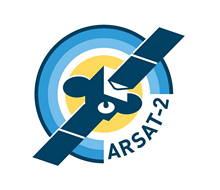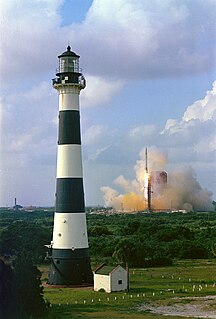Syncom started as a 1961 NASA program for active geosynchronous communication satellites, all of which were developed and manufactured by the Space and Communications division of Hughes Aircraft Company. Syncom 2, launched in 1963, was the world's first geosynchronous communications satellite. Syncom 3, launched in 1964, was the world's first geostationary satellite.

Radio is the technology of signaling and communicating using radio waves. Radio waves are electromagnetic waves of frequency between 30 hertz (Hz) and 300 gigahertz (GHz). They are generated by an electronic device called a transmitter connected to an antenna which radiates the waves, and received by another antenna connected to a radio receiver. Radio is very widely used in modern technology, in radio communication, radar, radio navigation, remote control, remote sensing, and other applications.
The Intelsat VI series of satellites were the 8th generation of geostationary communications satellites for the Intelsat Corporation. Designed and built by Hughes Aircraft Company (HAC) in 1983-1991, there were five VI-series satellites built: 601, 602, 603, 604, and 605.

The Boeing 601 is a communications satellite bus designed in 1985 and introduced in 1987 by Hughes Space and Communications Company. The series was extremely popular in the 1990s, with more than 84 purchased by customers globally. The more advanced 601HP derivative was introduced in 1995. Hughes, and the 601 platforms, were acquired by Boeing in 2000.
BSAT-1a was a geostationary communications satellite designed and manufactured by Hughes on the HS-376 platform. It was originally ordered and operated by the Broadcasting Satellite System Corporation (B-SAT). It was used as the main satellite to broadcast television channels for NHK and WOWOW over Japan. It had a pure Ku band payload and operated on the 110°E longitude until it was replaced, along its backup BSAT-1b, by BSAT-3a. On 3 August 2010, it was decommissioned and placed on a graveyard orbit.

ARSAT-2 is a geostationary communications satellite operated by ARSAT and built by the Argentine company INVAP. It was launched from French Guiana alongside Sky Muster satellite using an Ariane 5ECA rocket on September 30, 2015 at 20:30hs UTC, becoming the 400th satellite to be launched by Arianespace. It is licensed to be located at 81° West longitude geostationary slot. ARSAT-2 is the second geostationary satellite built in Argentina, after ARSAT-1. Structurally and mechanically it is a copy of the ARSAT-1, the only difference being the payload and thus it has different antenna configuration.
JCSAT-2A, known as JCSAT-8 before launch, is a geostationary communications satellite operated by SKY Perfect JSAT Group (JSAT) which was designed and manufactured by Boeing Satellite Systems on the BSS-601 platform. It has Ku-band and C-band payload and was used to replace JCSAT-2 at the 154° East longitude. It covers Japan, East Asia, Australia and Hawaii.
JCSAT-1B, known as JCSAT-5 before launch, is a geostationary communications satellite operated by SKY Perfect JSAT Group (JSAT) which was designed and manufactured by Hughes on the HS-601 satellite bus. It has a pure Ku-band payload and was used to replace JCSAT-1 at the 150° East longitude. It covers Japan, Korea, most of China, Thailand, Vietnam, Laos, part of Indonesia, part of Malaysia and Hawaii.
JCSAT-4 was known as JCSAT-R until it was sold to INTELSAT in 2009. It is a geostationary communications satellite designed and manufactured by Hughes on the HS-601 satellite bus. It was originally ordered by JSAT Corporation, which later merged into the SKY Perfect JSAT Group. It has a mixed Ku-band and C-band payload and was used as an on orbit spare.
JCSAT-3 was a geostationary communications satellite designed and manufactured by Hughes on the HS-601 satellite bus. It was originally ordered by JSAT Corporation, which later merged into the SKY Perfect JSAT Group. It has a mixed Ku-band and C-band payload and operated on the 128° East longitude until it was replaced by JCSAT-3A.
JCSAT-1 was a geostationary communications satellite designed and manufactured by Hughes on the HS-393 satellite bus. It was originally ordered by Japan Communications Satellite Company (JCSAT), which later merged into the JSAT Corporation. It had a Ku-band payload and operated on the 150° East longitude until it was replaced by JCSAT-1B.
JCSAT-2 was a geostationary communications satellite designed and manufactured by Hughes on the HS-393 satellite bus. It was originally ordered by Japan Communications Satellite Company (JCSAT), which later merged into the JSAT Corporation. It had a Ku-band payload and operated on the 154° East longitude until it was replaced by JCSAT-2A.
SBS 6 was a geostationary communications satellite designed and manufactured by Hughes on the HS-393 platform. It was originally ordered by Satellite Business Systems, which later sold it to Hughes Communications and was last used by Intelsat. It had a Ku band payload and operated on the 95°W longitude.
Superbird-C, also known as Superbird-3 or Superbird-A3, was a geostationary communications satellite ordered and operated by Space Communications Corporation (SCC) that was designed and manufactured by Hughes Space and Communications Company on the HS-601 satellite bus. It has a pure Ku-band payload and was used fill the position at 144° East longitude. It provided television signals and business communications services throughout Japan, South Asia, East Asia, and Hawaii.
Intelsat IV F-1 was a geostationary communication satellite built by Hughes, it was owned by Intelsat. The satellite was based on the HS-312 platform and its estimated useful life was 7 years.
Intelsat IV F-2 was a geostationary communication satellite built by Hughes and owned by Intelsat. The satellite was based on the HS-312 platform and its estimated useful life was 7 years.

Intelsat IV F-5 was a geostationary communication satellite built by Hughes, it was owned by Intelsat. The satellite was based on the HS-312 platform and its estimated useful life was 7 years.
Intelsat IV F-6 was a geostationary communication satellite built by Hughes, it was owned by Intelsat. The satellite was based on the HS-312 platform and its estimated useful life was 7 years.
Intelsat IV F-7 was a geostationary communication satellite built by Hughes, it was owned by Intelsat. The satellite was based on the HS-312 platform and its estimated useful life was seven years.
Intelsat IV F-8 was a geostationary communication satellite built by Hughes, it was owned by Intelsat. The satellite was based on the HS-312 platform and its estimated useful life was 7 years.




